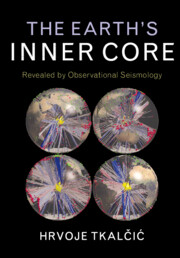Book contents
- Frontmatter
- Contents
- Preface
- Acknowledgements
- 1 On the History of Inner Core Discovery
- 2 Seismological Tools to Study the Inner Core
- 3 Inner Core Surface and Its Interior
- 4 Inner Core Anisotropy
- 5 Inner Core Rotational Dynamics
- 6 The Limitations, the Obstacles, and theWay Forward
- Appendix A Transmission/Reflection Coefficients for the Flat Inner Core Boundary
- Appendix B The Angle Between PKIKP Waves and the Rotation Axis of the Earth
- Appendix C P-Wave Velocity in a Transversely Isotropic Inner Core
- Appendix D Transdimensional Bayesian Inversion
- References
- Index
- Plate section
1 - On the History of Inner Core Discovery
Published online by Cambridge University Press: 26 January 2017
- Frontmatter
- Contents
- Preface
- Acknowledgements
- 1 On the History of Inner Core Discovery
- 2 Seismological Tools to Study the Inner Core
- 3 Inner Core Surface and Its Interior
- 4 Inner Core Anisotropy
- 5 Inner Core Rotational Dynamics
- 6 The Limitations, the Obstacles, and theWay Forward
- Appendix A Transmission/Reflection Coefficients for the Flat Inner Core Boundary
- Appendix B The Angle Between PKIKP Waves and the Rotation Axis of the Earth
- Appendix C P-Wave Velocity in a Transversely Isotropic Inner Core
- Appendix D Transdimensional Bayesian Inversion
- References
- Index
- Plate section
Summary
“… and this leads us to the perception that the Earth consists of an iron core with a diameter of approximately 10 million metres, enclosed by a rocky mantle with a thickness of 1½ million metres.”
Emil Wiechert (Wiechert, 1897)“It is, however, by no means certain that a regular increase of the elastic constants to the Earth's centre is to be looked for; on the contrary, a sudden change is to be looked for where the wave paths leave the outer stony shell to enter the central metallic core which may reasonably be supposed to exist.”
Richard D. Oldham (Oldham, 1900)“We must therefore examine the possibility that the Oldham–Gutenberg discontinuity is also the outer boundary of the metallic core.”
“There seems to be no reason to deny that the Earth's metallic core is truly fluid.”
Harold Jeffreys (Jeffreys, 1926b)“However, the interpretation seems possible, and the assumption of the existence of an inner core is, at least, not contradicted by the observations; these are, perhaps, more easily explained on this assumption.”
Inge Lehmann (Lehmann, 1936)“The first results for the properties of the inner core were naturally approximate. Much has been written about it, but the last word has probably not yet been said.”
Inge Lehmann (Lehmann, 1987)Early Days of Modern Science
Halley (1686) was likely the first to mention the Earth's core within the context of natural philosophy as a ‘nucleus’ or ‘inner globe’, detached from the Earth's external shell. According to Halley's model, the ‘nucleus’ or ‘inner globe’ of the Earth is a solid innermost sphere with two moveable magnetic poles which is detached from, and rotates differentially with respect to, the rest of the planet (Figure 1.1). Its existence was invoked to explain apparent observations of four magnetic poles, which were later understood to be evidence of the spatial variation of a magnetic field containing a superposition of both dipole and non-dipole components. In one of the model's variations, the Moon-sized inner globe is separated from the Earth's outer, 800 km thick shell by a liquid layer that has the same axis of diurnal rotation and the centre of gravity as the inner core (IC).
This ‘Hollow Earth’ model was driven by erroneous estimates of the Earth– Moon density ratio (Newton, 1687), but the idea persisted in literature for centuries.
- Type
- Chapter
- Information
- The Earth's Inner CoreRevealed by Observational Seismology, pp. 1 - 6Publisher: Cambridge University PressPrint publication year: 2017



